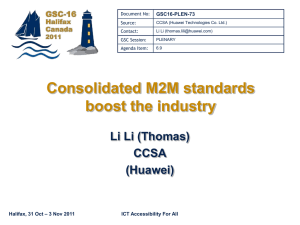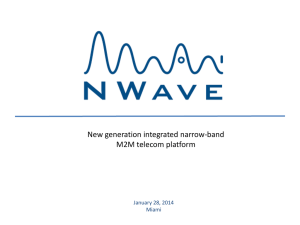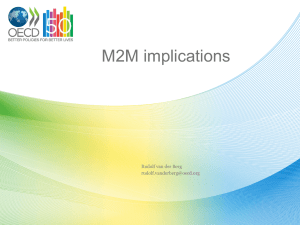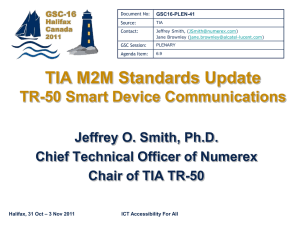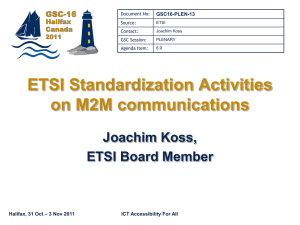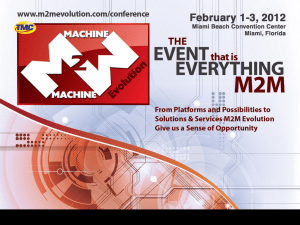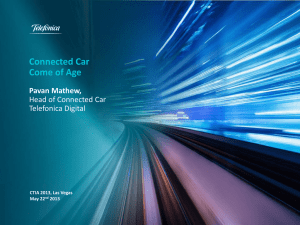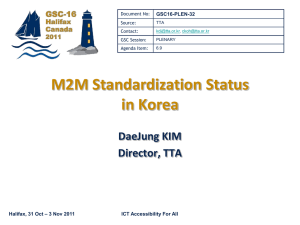GSC16-PLEN-82 - GSC-16 Halifax Canada 2011
advertisement
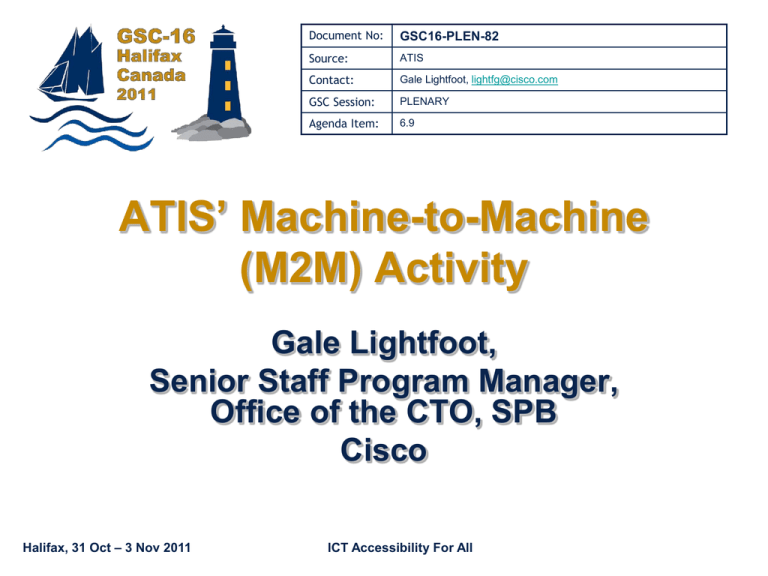
Document No: GSC16-PLEN-82 Source: ATIS Contact: Gale Lightfoot, lightfg@cisco.com GSC Session: PLENARY Agenda Item: 6.9 ATIS’ Machine-to-Machine (M2M) Activity Gale Lightfoot, Senior Staff Program Manager, Office of the CTO, SPB Cisco Halifax, 31 Oct – 3 Nov 2011 ICT Accessibility For All Highlight of Current Activities • ATIS TOPS Council and Board created its Machine-to-Machine Focus Group (M2M FG) to address M2M, Smart Grid, and Connected Vehicle opportunities – Co-Chaired by Jeff Edlund, HP, and Gale Lightfoot, Cisco. • Sub-teams currently include: – (Telematics) Connected Vehicle – (Telemetry) Smart Grid • Sub-teams meet weekly to consider: – Use Cases – Architecture Study – Protocol/API Analysis 2 GSC16-PLEN-82 Highlight of Current Activities (2) • Currently assessing – In depth Use Case Analysis for M2M, Smart Grid, eHealth, and Connected Vehicle • Discover common requirements/specifications – Architectural definition for M2M Service Platform • Seeking common Service Layer “elements” that enhance overall value of M2M services/applications – Identification of players across the value chain Halifax, 31 Oct – 3 Nov 2011 ICT Accessibility For All 3 M2M Value Chain Module Network Middleware System Integrator Service Provider End User Machine GSC16-PLEN-82 Middleware Providers Service Providers Machine & Device Manufacturers Network Equipment Providers System Integrators Application Developers Halifax, 31 Oct – 3 Nov 2011 ICT Accessibility For All 4 Strategic Direction GSC16-PLEN-82 • Opportunity to define ICT’s contribution and role in these emerging markets. • Continue to discover area(s) of common ground where Verticals and ICT’s potentially converge. • The mobility aspect of all M2M-related activities makes ICT’s role critical. • M2M value-added services remain a relatively untapped market for ICT. • Opportunity to examine potential use of the same features/functions and parameters to support a common M2M service platform. Halifax, 31 Oct – 3 Nov 2011 ICT Accessibility For All 5 Strategic Direction (2) GSC16-PLEN-82 • The M2M potential for complexity is enormous – Must seek reduction of complexity! – Forecasted >15B Connected Devices by 2015; >50B by 2020! – Subscriber saturation in the U.S. has occurred. There are now more mobile subscriptions than U.S. residents. • Service Enabling Platform! – Machines and sensors represent the clearest way for mobile revenue and services to grow. • Requires developer friendly environment – Many telemetry applications do not use much bandwidth. • Much more activity • QoS issues! – Attraction is similar to short message service: high margins, low bandwidth consumption. • Much more activity • QoS issues! Halifax, 31 Oct – 3 Nov 2011 ICT Accessibility For All 6 Challenges GSC16-PLEN-82 • M2M activities involve a broad cast of players from multiple industries with varying terminology. • Many “moving parts” currently being developed without thought of seeking “common threads”. • Converging of multiple platforms. • Establishing a “Trusted Environment” for all businesses associated with vertical services/applications. Halifax, 31 Oct – 3 Nov 2011 ICT Accessibility For All 7 Next Steps/Actions GSC16-PLEN-82 • Coordinate and align M2M activities with other SDOs and organizations. • Continued interaction and collaboration with the verticals (e.g., eHealth, Smart Grid, etc.) providers. • Use Case assessment used to sift out service layer commonalities across different verticals. Halifax, 31 Oct – 3 Nov 2011 ICT Accessibility For All 8 Proposed Resolution GSC16-PLEN-82 • ATIS proposes revisions to the existing M2M Resolution contained in: – GSC-15/30: Machine to Machine GSC-16-CL-xx 27 October 2011 RESOLUTION GSC-16/30: (Plenary) Machine to Machine (Revised) The 16th Global Standards Collaboration meeting (Halifax, 31 October - 3 November 2011) Recognizing: a) Beyond the 5 billion devices connected to the Internet, with an expectation of 15 billion devices by 2015, the potential for greatest growth comes from machine-to-machine (M2M) deployments, involving networked security cameras and sensors, connected home appliances and HVAC equipment, ITS infrastructure for traffic and parking management, sophisticated smart grids etc. b) The phenomenal growth of applications that are continuing to be available on these devices that will create tremendous demands and increased complexity in the network. c) M2M is seeing positive industry trends and is recognized globally by governments and private initiatives. d) The M2M market has huge potential both in terms of size and growth for all parties involved in the M2M value chain. e) The availability of global standards will be an important enabler for connecting multiple devices in complex systems and reaching economies of scale, for manufacturers and solution providers. Considering: a) That standards are most conducive to economies of scale if they are compatible worldwide. b) That many organizations around the world, including PSOs, are working on M2M standardization; thereby increasing the possibility of redundant or conflicting standards. c) That global coordination and collaboration will reduce the risk of standards duplication and will increase standardization effectiveness. d) That coherent global standards should be developed whenever feasible. e) That M2M introduces new components that are distinct from user communications and need to be made coherent with the work of existing communication networks including NGN. f) That GSC’s mission is to reduce duplication, foster synergy, and encourage coherence. Resolves: 1) To establish a GSC M2M Standardization Task Force (MSTF) to facilitate global coordination and harmonization. 2) To openly share relevant M2M material through liaisons, meeting invitations, etc. 3) To outline the worldwide M2M activity map and make recommendations on current and future activities. Halifax, 31 Oct – 3 Nov 2011 ICT Accessibility For All 9


